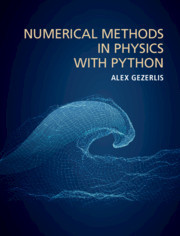Description
Numerical Methods in Physics with Python
Author: Gezerlis Alex
A standalone text for courses on computational physics combining idiomatic Python, foundational numerical methods, and physics applications.
Language: English
Subject for Numerical Methods in Physics with Python:
Approximative price 121.50 €
In Print (Delivery period: 14 days).
Add to cart
Numerical Methods in Physics with Python
Publication date: 08-2020
504 p. · 19.4x25.2 cm · Hardback
Publication date: 08-2020
504 p. · 19.4x25.2 cm · Hardback
Approximative price 54.78 €
In Print (Delivery period: 14 days).
Add to cart
Numerical Methods in Physics with Python
Publication date: 08-2020
604 p. · 18.9x24.5 cm · Paperback
Publication date: 08-2020
604 p. · 18.9x24.5 cm · Paperback
Description
/li>Contents
/li>Biography
/li>
Bringing together idiomatic Python programming, foundational numerical methods, and physics applications, this is an ideal standalone textbook for courses on computational physics. All the frequently used numerical methods in physics are explained, including foundational techniques and hidden gems on topics such as linear algebra, differential equations, root-finding, interpolation, and integration. Accompanying the mathematical derivations are full implementations of dozens of numerical methods in Python, as well as more than 250 end-of-chapter problems. Numerical methods and physics examples are clearly separated, allowing this introductory book to be later used as a reference; the penultimate section in each chapter is an in depth project, tackling physics problems which cannot be solved without the use of a computer. Written primarily for students studying computational physics, this textbook brings the non-specialist quickly up to speed with Python before looking in detail at the numerical methods often used in the subject.
Preface; List of codes; 1. Idiomatic python; 2. Numbers; 3. Derivatives; 4. Matrices; 5. Roots; 6. Approximation; 7. Integrals; 8. Differential equations; Appendix A. Installation and setup; Appendix B. Number representations; Appendix C. Math background; Bibliography; Index.
Alex Gezerlis is an Associate Professor of Physics at the University of Guelph. Before moving to Canada, he worked in Germany, the United States, and Greece. He has received several research awards, grants, and allocations on supercomputing facilities and is active in teaching at both undergraduate and graduate levels.
© 2024 LAVOISIER S.A.S.




